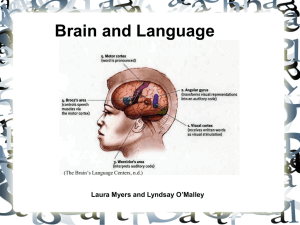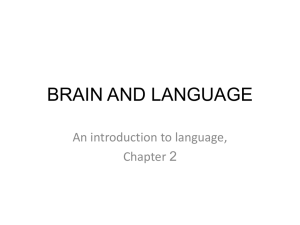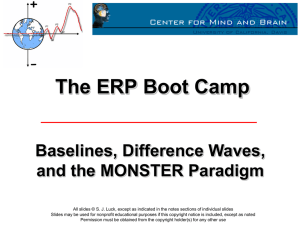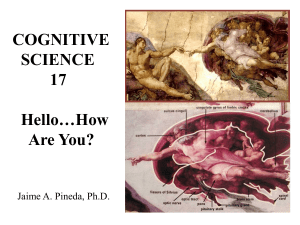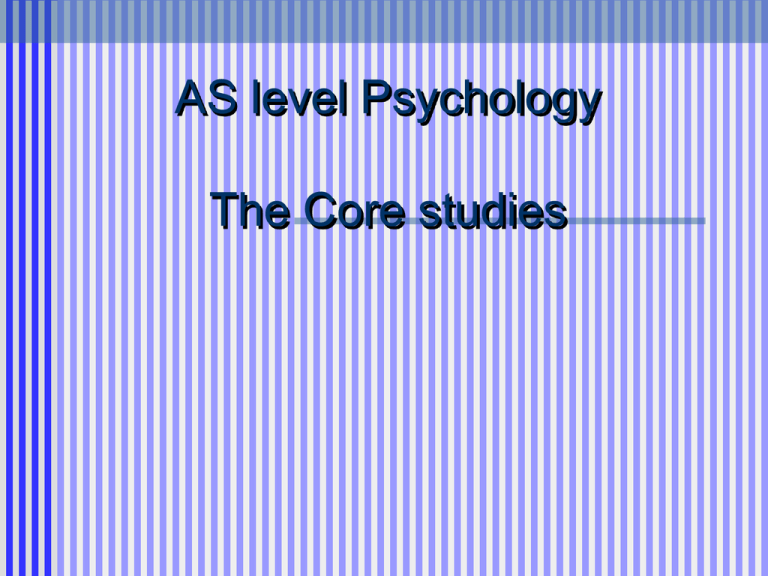
AS level Psychology
The Core studies
The Split Brain Studies - R Sperry 1968
THREE Questions...
What happens when the two halves of the
brain are disconnected?
Do the hemispheres perform different
functions?
Does each hemisphere have its own
memories, perceptions and concepts?
Some background….
Why are there two halves to the brain?
The corpus callosum joins the two halves of
the brain
A commissurotomy is the division of the
two hemispheres by surgery
The two hemispheres
The RIGHT side of the brain processes
info from LEFT half of body
The LEFT side of brain processes info
from RIGHT half of body
VISUAL PATHWAYS CROSS OVER
Brain Functions
The supposition
The left half of the brain is specialised for
language
linguistic expression both symbolic and logical
The right half of the brain is specialised
for perception
visuospatial and artistic
Brain Functions
Can this be supported by evidence?
Sperry’s experiment was
A NATURAL EXPERIMENT
11 participants
Sperry’s Ps were epileptics who could not
be treated with drugs
The split brain procedure
The subject has one eye covered
Gazes at a fixation point on an upright
translucent screen
slides are projected either side of the
fixation point for 1/10th sec
The split brain procedure
What happened?
When an object is displayed on one half
of the screen (ie the left) and then in the
other the P has no recollection of seeing it
before
TWO SEPARATE MEMORIES?
The split brain procedure
Speech and writing
When an object is displayed in the right
visual field (thus processed in the left
hemisphere) Ps can describe it in speech
and writing
The split brain procedure
Speech and writing
When an object is displayed in the left
visual field (thus processed in the right
hemisphere) Ps insist they have not seen
anything
BUT
if asked to use the LEFT HAND to point to a
matching object on the table can do so, while
STILL insisting nothing was seen
The split brain procedure
TWO different objects displayed
e.g. CASE and KEY
Ps asked to draw what they see with their
left hand
DREW what was on the LEFT half of the
screen (CASE)
BUT said they had drawn what was on
the RIGHT half of the screen (KEY)
The split brain procedure
OBJECTS placed in RIGHT HAND for
IDENTIFICATION BY TOUCH
Ps described the object in speech and
writing
OBJECTS placed in LEFT HAND for
IDENTIFICATION BY TOUCH
Ps made wild guesses - seemed unaware
of object in their hand
The split brain procedure
Two different objects placed in each hand - then
hidden for retrieval in pile of items
Each
hand hunts searching for its
own object but ...If the left hand picks
up the object which the right hand is
looking for, the object is rejected…
but the other hand continues to
search!!!
The split brain procedure
An APPLE flashed LEFT side of the screen
If the P uses his LEFT HAND to find an apple
on the ‘table’ he cannot name each object he
picks up but can pick up the apple
If he uses his RIGHT HAND he can name each
object he picks up - but cannot SAY what his
RIGHT hand is searching for
Because the RIGHT hemisphere that could
recognise the correct answer gets no feedback
from the RIGHT hand
Has the right hemisphere
the ability to process
language?
The hemisphere that processes
language (usually the left) is known
as the major hemisphere.
The other hemisphere is known as
the minor hemisphere.
Sperry was able to demonstrate
limited language processing ability
in the minor (right) hemisphere.
In one experiment a picture of a wall
clock would be shown to the minor
hemisphere, and the patient was
able to pick out a wristwatch with
the left hand (which is controlled by
the right hemisphere).
As a wristwatch is physically nothing
like a wall clock, it can be assumed
that the patient was not guided by a
visual image alone.
It is reasonable to assume that
semantic processing took place, as
the link between the two objects
(being their similarity of function) is
purely semantic.
In another experiment, when the
subject was asked to pick out a
'piece of silverware', for example,
their left hand could successfully
retrieve a fork.
Can the right hemisphere
perform calculations?
Sperry was also able to demonstrate that
the right hemisphere can perform simple
arithmetical calculations. This is normally
more efficiently performed within the left
hemisphere. Simple sums would be
presented to the left visual field, and
therefore processed by the right
hemisphere. The left hand was able to
indicate the answer by pointing to or
writing the correct answer.
Emotion in the right
hemisphere
The minor (right) hemisphere can
express emotion. A pin-up of a nude
presented in the left visual field (and
hence processed by the right
hemisphere) would produce blushing
or giggling, but no verbal report of
having seen the picture.
Emotion in the right
hemisphere
An unpleasant smell presented to the
right hemisphere (through the right
nostril) would produce the response
'phew' but no verbal report of what
the smell was like.
The split brain procedure
Conclusion
It seems that one half of the brain does
not know what the other half is doing
The split brain procedure
SUMMARY
The LEFT hemisphere (in right handed people)
is specialised for speech and writing and for the
organisation of language
It can communicate the visual experiences of
the RIGHT VISUAL FIELD and about the
experiences of the RIGHT half of the body
The split brain procedure
SUMMARY
The RIGHT hemisphere is MUTE and
cannot speak or write
(aphasic and agraphic)
but can show NON VERBALLY that
mental processes, centred around the
LEFT VISUAL FIELD and the LEFT half of
the BODY, are present
Role of each Hemisphere
Left
Right
Speech
Production of
speech,
comprehension of
the literal meaning
of speech
Emotional
inflections,
understanding
jokes & humour,
sarcasm,
emotional content
of speech
Role of each Hemisphere
Left
Right
Auditory System
Sounds related to
speech
Emotions
Expressions of
happiness
Non-language
environmental sounds
(e.g., rain)
Music
Expressions of anger,
fear, disgust;
interpreting the
emotional expressions
of other people
Role of each Hemisphere
Left
Right
Vision
Details
Overall
configuration;
spatial processing
(e.g., arranging
pieces of a puzzle
or drawing a
picture)
Role of each Hemisphere
Left
Right
Mode or Style
(How data are
processed)
Details, parts,
pieces
Gestalt,
overall
configuration;
global form
Role of each Hemisphere
Left
Right
Spatial
Frequency
Hypothesis
(What data are
processed)
High spatial
frequency:
many and
frequent visual
changes
Low spatial
frequencies:
few visual changes
In the following
examples what
layout do you
prefer?
Role of each Hemisphere
Left
Right
High spatial
frequency
Low spatial
frequencies:
Role of each Hemisphere
Right
Left
Low spatial
frequencies:
High spatial
frequency
EVALUATION & Criticism
The Ps were epileptic CAN they be said to represent NORMAL
brains?
INDIVIDUAL DIFFERENCES - some
people have more lateralised brains
EVALUATION & Criticism
SEX DIFFERENCES
Women have less lateralised brains
Perhaps RIGHT HANDED male brains
are more RIGHT <> LEFT specialised?
KIMURA reported more aphasia in men
who had left brain damage
EVALUATION & Criticism
A REDUCTIONIST explanation for
human behaviour
(BRAIN not MIND)
Most tasks involve a mixture of LEFT and
RIGHT brain skills
When we hear speech we decode
meaning from the WORDS AND the
EMOTIONAL TONE in the voice
The split brain procedure
Do
the two halves of the brain
represent two minds?
Evidence
Hemispherectomy
- the removal of
one half of the brain…..
the
SELF remained
The split brain procedure
SPERRY
When
said…
the brain is disconnected
we see two separate selves,
each with its own memory and
will
The split brain procedure
MACKAY
Not
(1987) said...
TWO people with TWO free
wills... but one person who under
certain circumstances is liable to
show a strange form of absent
mindedness
The split brain procedure
What
do you think?
SPERRY - QUESTIONS
Does the size of the sample matter?
What was unusual about the participants?
Why was this a NATURAL experiment?
What was the IV?
Are there any ethical problems?
Roger Sperry (1968) was given a
NOBEL PRIZE for this research
READ
this study up
THE END






